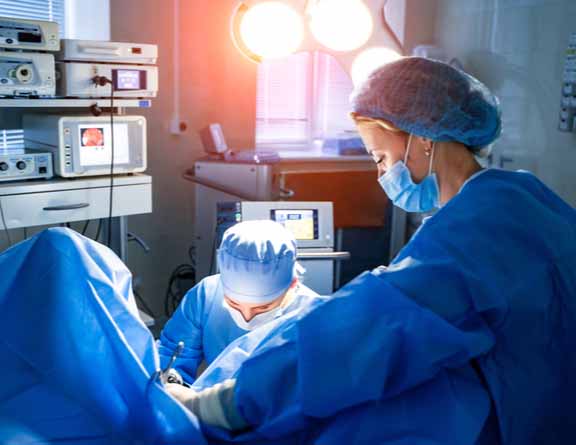
Durg
USFDA Approved Procedures
Minimally invasive. Minimal pain*.
Insurance Paperwork Support
1 Day Procedure
Also known as a surfer’s eye, Pterygium is a fleshy, wing-like growth on the eye. Derived from two Greek words, i.e., pteryx (meaning wing) and pterygion (meaning fin), it is a fibrovascular overgrowth of the subconjunctival tissues that covers the sclera and the cornea. It usually starts around the nose and gradually progresses toward the pupil area.
People often feel scared when this growth appears, believing it to be cancerous. However, pterygium is not cancerous. The growth usually occurs in both eyes and spreads slowly. In many cases, it stops after a certain point. But in some people, pterygium continues to progress and cover the pupil, leading to vision problems.
If you have these triangular, wedge-like growths and you wish to undergo pterygium surgery in Durg, get in touch with Pristyn Care.

There are two types of pterygium-

Treatment
A complete eye exam is important before planning pterygium surgery. The exam includes a visual acuity test, slit lamp exam, keratometry, corneal topography, and an examination of the bulbar and palpebral conjunctiva. If the results of these examinations show that the surgery is a safe choice for pterygium treatment, the surgery is planned.
At Pristyn Care, our eye doctors perform pterygium surgery using the following techniques-
Excision with Conjunctival Autograft- It is a very effective technique for the surgical removal of pterygium. When the pterygium is removed, a graft is taken from the healthy conjunctival tissues and used to cover the sclera from where the pterygium was removed. It is considered the gold standard for pterygium treatment because of the low recurrence rate.
Excision with Amniotic Membrane Graft- This technique is also effective and considered an alternative to the conjunctival autograft. After the removal of the pterygium, the amniotic membrane is placed over the sclera and secured with fibrin glue or sutures. This approach is chosen when the conjunctiva needs to be spread for future surgical treatments, such as glaucoma surgery.
Mitomycin C (MMC)- It is an adjunctive therapy that is used to suppress fibroblasts. MMC is an alkaline agent that prevents DNA synthesis. Due to the DNA synthesis inhibition property, this agent is often used during and/or after pterygium surgery to prevent the growth of the tissues and preserve the corneal endothelium and epithelium.
Delivering Seamless Surgical Experience in India
Your safety is taken care of by thermal screening, social distancing, sanitized clinics and hospital rooms, sterilized surgical equipment and mandatory PPE kits during surgery.
A dedicated Care Coordinator assists you throughout the surgery journey from insurance paperwork, to free commute from home to hospital & back and admission-discharge process at the hospital.
Our surgeons spend a lot of time with you to diagnose your condition. You are assisted in all pre-surgery medical diagnostics. We offer advanced laser and laparoscopic surgical treatment. Our procedures are USFDA approved.
We offer free follow-up consultations and instructions including dietary tips as well as exercises to every patient to ensure they have a smooth recovery to their daily routines.
Excision surgery is one of the oldest techniques used for pterygium removal. This technique involved removing only the overgrown tissues from the eye. However, simple excision with bare sclera had low success rates and up to 80% risk of recurrence. Thus, this technique was considered unacceptable, and advancements were made in the conventional approach with the help of conjunctival autograft and amniotic membrane graft.
Yes, pterygium surgery expenses are covered by health insurance. It is a progressive disorder that can impair vision if left untreated. Thus, the treatment is considered a medical necessity and covered by all health insurance providers under the base policy. To learn more about the terms and conditions regarding the coverage and claim, talk to your health insurance provider.
Pterygium is an overgrowth that is usually progressive in nature and arises from a pinguecula. Unlike a pterygium, pseudopterygium is non-progressive and arises due to trauma or injury to the corneal epithelium. Another key difference is that a true pterygium can be lifted with a probe. However, in pseudopterygium, the conjunctiva migrates to the injured area and attaches with it, hence, it shows no tendency to be lifted with a probe.
Pterygium is a common ocular surface lesion that covers the sclera and the cornea. Generally, the lesion growth is benign, but in some cases, it can interfere with vision. If your vision is compromised due to pterygium growth and you wish to seek treatment, you can contact Pristyn Care.
We provide safe and effective treatment for pterygium through surgery. We have a team of highly experienced eye doctors who specialize in treating pterygium and other conditions that can affect vision. Our doctors thoroughly diagnose the patients and suggest a pterygium surgery technique that is most suitable for them. To learn all about pterygium surgery, give us a call and book your free consultation with our eye specialists in Durg.
Being a full-stack healthcare provider, Pristyn Care takes a patient-centric approach to provide best-in-class medical care to all patients. We leverage modern techniques and USFDA-approved diagnostic and surgical instruments to help people whose vision is compromised by pterygium. Our primary goal is to make advanced pterygium treatment easily accessible and affordable for people.
The benefits of choosing Pristyn Care for pterygium surgery in Durg are-
Throughout the treatment journey, our representatives will stay in touch to assist you at every step.
.svg)
.svg)